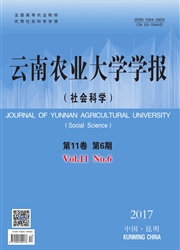

 中文摘要:
中文摘要:
云南高寒稻区的地方粳稻品种小麻谷与籼稻细胞质的改良品系南 34的正反交 F1分别种植于海拔 400,1860和 2200m的 3个点,对 6个 F2群体的孕穗期耐冷性进行分析。结果表明小穗育性是对低温最敏感的性状,可用作孕穗期耐冷性的评价指标。F2(小麻谷 ×南 34)群体的平均孕穗期耐冷性均极显著高于同一海拔下产生的反交 F2群体的表现 (P<001)。同一组合在2200m海拔产生的 F2群体平均孕穗期耐冷性均高于其余两海拔产生的群体,其中显著 (P<005)或极显著 (P<001)高于在 400m海拔产生的群体。结果明确了杂种 F1在高海拔低温条件下传粉产生的后代更耐低温,其中在粳稻细胞质背景下更为明显。在 F2(小麻谷 ×南 34)群体中耐冷性状的分布主要是受耐冷基因的作用,然而在其反交 F2群体中耐冷性状的分布除受耐冷基因的作用外,还受到籼稻细胞质背景的影响。
 英文摘要:
英文摘要:
The average cold tolerance at booting stage of six F2 populations generated from the reciprocal FI hybrids grown at three different altitudes of 400, 1 860 and 2 200 m, were compared under low temperature treatment. The material parents are Xiaomagu, japonica rice landrace grown at Yunnan al- pine region at 2 650 m, and Nan34, an improved line that cytoplasm donated by indica rice. The re- sults revealed that spikelet fertility was the most sensitive characteristics, could be used as indicator of cold tolerance evaluation at booting stage. The average cold tolerance at booting stage of F2 (Xi- aomagu x Nan34) population was extremely significantly higher than its reciprocal F2 population gener- ated from same altitude (P 〈 0. 01 ). In the same cross, the average cold tolerance at booting stage of Fz populations generated from 2200m was higher than those generated from other altitudes, and they were significantly (P 〈0. 05) or extremely significantly (P 〈0. 01 ) higher than those generated from400m altitude. The results demonstrated that the progenies generated from the hybrid F~ s pollinated at high altitude had stronger cold tolerance than those pollinated at low altitude, especially under japonica cytoplasm backgrounds. The distribution of spikelet fertility under low temperature conditions is mainly controlled by cold tolerance gene (s) in F2 ( Xiaomagu × Nan 34) populations, however, it is also strongly affected by indica cytoplasm in its reciprocal F2 populations.
 同期刊论文项目
同期刊论文项目
 同项目期刊论文
同项目期刊论文
 期刊信息
期刊信息
